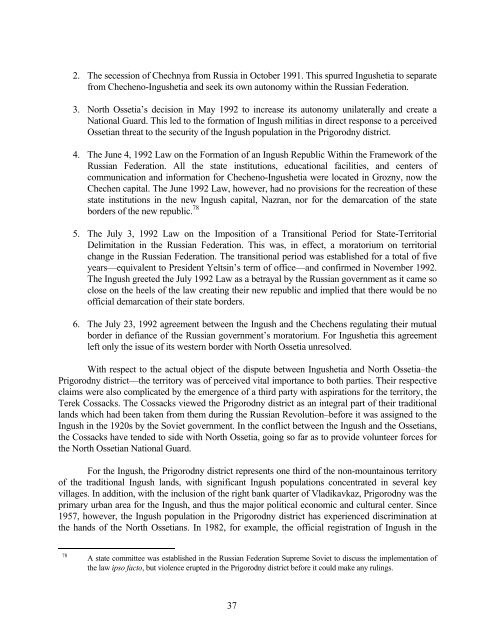RUSSIA'S TINDERBOX - Belfer Center for Science and International ...
RUSSIA'S TINDERBOX - Belfer Center for Science and International ...
RUSSIA'S TINDERBOX - Belfer Center for Science and International ...
Create successful ePaper yourself
Turn your PDF publications into a flip-book with our unique Google optimized e-Paper software.
2. The secession of Chechnya from Russia in October 1991. This spurred Ingushetia to separate<br />
from Checheno-Ingushetia <strong>and</strong> seek its own autonomy within the Russian Federation.<br />
3. North Ossetia’s decision in May 1992 to increase its autonomy unilaterally <strong>and</strong> create a<br />
National Guard. This led to the <strong>for</strong>mation of Ingush militias in direct response to a perceived<br />
Ossetian threat to the security of the Ingush population in the Prigorodny district.<br />
4. The June 4, 1992 Law on the Formation of an Ingush Republic Within the Framework of the<br />
Russian Federation. All the state institutions, educational facilities, <strong>and</strong> centers of<br />
communication <strong>and</strong> in<strong>for</strong>mation <strong>for</strong> Checheno-Ingushetia were located in Grozny, now the<br />
Chechen capital. The June 1992 Law, however, had no provisions <strong>for</strong> the recreation of these<br />
state institutions in the new Ingush capital, Nazran, nor <strong>for</strong> the demarcation of the state<br />
borders of the new republic. 78<br />
5. The July 3, 1992 Law on the Imposition of a Transitional Period <strong>for</strong> State-Territorial<br />
Delimitation in the Russian Federation. This was, in effect, a moratorium on territorial<br />
change in the Russian Federation. The transitional period was established <strong>for</strong> a total of five<br />
years—equivalent to President Yeltsin’s term of office—<strong>and</strong> confirmed in November 1992.<br />
The Ingush greeted the July 1992 Law as a betrayal by the Russian government as it came so<br />
close on the heels of the law creating their new republic <strong>and</strong> implied that there would be no<br />
official demarcation of their state borders.<br />
6. The July 23, 1992 agreement between the Ingush <strong>and</strong> the Chechens regulating their mutual<br />
border in defiance of the Russian government’s moratorium. For Ingushetia this agreement<br />
left only the issue of its western border with North Ossetia unresolved.<br />
With respect to the actual object of the dispute between Ingushetia <strong>and</strong> North Ossetia–the<br />
Prigorodny district––the territory was of perceived vital importance to both parties. Their respective<br />
claims were also complicated by the emergence of a third party with aspirations <strong>for</strong> the territory, the<br />
Terek Cossacks. The Cossacks viewed the Prigorodny district as an integral part of their traditional<br />
l<strong>and</strong>s which had been taken from them during the Russian Revolution–be<strong>for</strong>e it was assigned to the<br />
Ingush in the 1920s by the Soviet government. In the conflict between the Ingush <strong>and</strong> the Ossetians,<br />
the Cossacks have tended to side with North Ossetia, going so far as to provide volunteer <strong>for</strong>ces <strong>for</strong><br />
the North Ossetian National Guard.<br />
For the Ingush, the Prigorodny district represents one third of the non-mountainous territory<br />
of the traditional Ingush l<strong>and</strong>s, with significant Ingush populations concentrated in several key<br />
villages. In addition, with the inclusion of the right bank quarter of Vladikavkaz, Prigorodny was the<br />
primary urban area <strong>for</strong> the Ingush, <strong>and</strong> thus the major political economic <strong>and</strong> cultural center. Since<br />
1957, however, the Ingush population in the Prigorodny district has experienced discrimination at<br />
the h<strong>and</strong>s of the North Ossetians. In 1982, <strong>for</strong> example, the official registration of Ingush in the<br />
78 A state committee was established in the Russian Federation Supreme Soviet to discuss the implementation of<br />
the law ipso facto, but violence erupted in the Prigorodny district be<strong>for</strong>e it could make any rulings.<br />
37
















